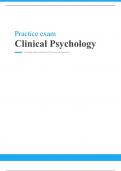Exam (elaborations)
Clinical Psychology practice exam
- Course
- Institution
- Book
Improve your exam preparation with this practice test! It contains 135 multiple choice and 20 open questions, including the correct answers from both. The practice test covers key topics from your lectures , two chapters and two articles.
[Show more]



